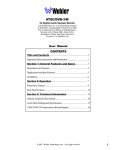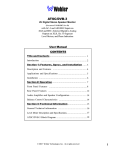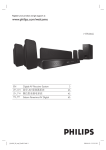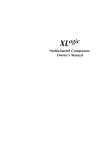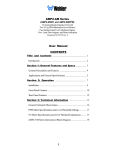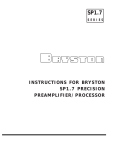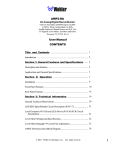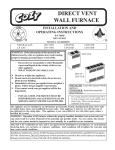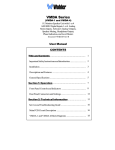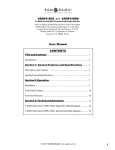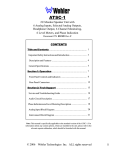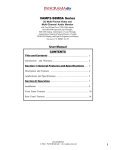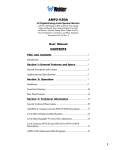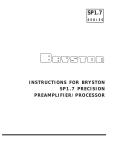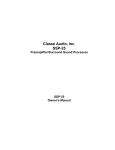Download Wohler ATSC/DVB-3/SDI User manual
Transcript
ATSC/DVB-3/SDI 2U Digital Audio Speaker Monitor with SDI, AC-3, and AES Inputs on XLR and BNC, Analog Stereo Output of Selected Source on XLR, Six 53-Segment Level Meters and Phase Indication Document P/N 821557 Rev. A User Manual CONTENTS Title and Contents ............................................................. 1 Introduction ...................................................................................... 2 Section 1: General Features and Specs .................. 3 Description and Features .................................................................. 4 Applications and Specifications..................................................... 5 Section 2: Operation ........................................................ 7 Installation ....................................................................................... 9 Front Panel Features ........................................................................ 10 Rear Panel Features .................................................................... 14 Section 3: Technical Information ................................ 17 General Technical Observations ................................................... 18 SDI to AES/EBU PCB (919096) Description ................................. 19 Level Meter Settings and Specifications ........................................ 20 ATSC/DVB-3/SDI Interconnect Block Diagram ............................ 21 1 Important Safety Instructions 1) Read these instructions. 2) Keep these instructions. 3) Heed all warnings. 4) Follow all instructions. 5) Do not use this apparatus near water. 6) Clean only with dry cloth. 7) Do not block any ventilation openings. Install in accordance with the manufacturer's instructions. 8) Do not install near any heat source such as radiators, heat registers, stoves, or other apparatus (including amplifiers) that produce heat. 9) Do not defeat the safety purpose of the polarized or grounding-type plug. A polarized plug has two blades with one wider than the other. A grounding type plug has two blades and a third grounding prong. The wide blade or the third prong are provided for your safety. If the provided plug does not fit into your outlet, consult an electrician for replacement of the obsolete outlet. 10) Protect the power cord from being walked on or pinched, particularly at plugs convenience receptacles and the point where they exit from the apparatus. 11) Only use attachments/accessories specified by the manufacturer. 12) Use only with the cart stand, tripod, bracket, or table specified by the manufacturer, or sold with the apparatus. When a cart is used, use caution when moving the cart/apparatus combination to avoid injury from tip-over. 13) Unplug this apparatus during lightning storms or when unused for long periods of time. 14) Refer all servicing to qualified service personnel. Servicing is required when the apparatus has been damaged in any way, such as when power-supply cord or plug is damaged, liquid has been spilled or objects have fallen into the apparatus, the apparatus has been exposed to rain or moisture, does not operate normally, or has been dropped. 15) Do not expose this apparatus to rain or moisture. 16) The apparatus shall be connected to a mains socket outlet with a protective earthing connection. CAUTION! In products featuring an audio amplifier and speakers, the surface at the side of the unit, where the audio amplifier heat sink is internally attached, may get very hot after extended operation. When operating the unit excercise caution when touching this surface and ensure that external materials which may be adversely affected by heat are not in contact with it. There is a Hot Surface label (see diagram) attached to the aforementioned surface of the product. Introduction Congratulations on your selection of a Wohler Technologies product. We are confident it represents the best performance and value available, and we guarantee your satisfaction with it. If you have questions or comments you may contact us at: Wohler Technologies, Inc. 31055 Huntwood Avenue Hayward, CA 94544 Phone: (510) 870-0810 Fax: (510) 870-0811 US Toll-Free: 1-888-596-4537 www.wohler.com 2 [email protected] © 2007 Wohler Technologies, Inc. ALL rights reserved ATSC/DVB-3/SDI User Manual P/N 821557 Rev-A Sect. 1: General Features and Specifications Section 1 General Features and Specifications Description Features Applications Specifications Other Options © 2003 Wohler Technologies Inc. ALL rights reserved 3 ATSC/DVB-3/SDI User Manual P/N 821557 Rev-A Section 1: General Features and Specifications ATSC/DVB-3/SDI 2U Stereo Digiotal Audio Speaker Monitor AVG O OUT IN POWER 1 WOHLER TECHNOLOGIES 2 3 0 2 4 7 10 13 16 18 20 22 25 28 31 34 38 42 46 51 56 66 4 SDI GROUP SELECTOR DISABLED 3 4 2 1 LEFT SPEAKER SELECT 5 6 L FRONT 1 INPUT STATUS 0 2 4 7 10 13 16 18 20 22 25 28 31 34 38 42 46 51 56 66 R FRONT 2 AC-3 0 2 4 7 10 13 16 18 20 22 25 28 31 34 38 42 46 51 56 66 PCM 1 SDI 2 PRO-16 SELECT INPUT SOURCE 1 -AES ALL 2 -SDI SELECTED CENTER 3 LF EFX 4 SOURCE 0 2 4 7 10 13 16 18 20 22 25 28 31 34 38 42 46 51 56 66 L SURR 5 1 ATSC/DVB-3/SDI DIGITAL AUDIO MONITOR PANEL 2 SUBGROUP SELECTOR DISABLED 3 2 R SURR 6 SOURCE 1 4 5 6 RIGHT SPEAKER SELECT ATSC/DVB-3/SDI Front Panel Description The ATSC/DVB-3/SDI is a powered stereo monitor designed specifically for flexible, comprehensive monitoring of the six audio channels associated with ATSC/DVB programming. The unit is 2RU in size, for excellent fidelity without using excessive rackspace in the critical "operating zone" of rack bays and consoles. The ATSC/DVB-3/SDI monitors SDI (Serial Digital Interface), PCM (Pulse Code Modulation), AES/EBU, and AC-3 (Dolby Digital®) signals providing capabilities to handle monitoring requirements throughout the facility. The speakers and amplifiers are arranged in the popular Wohler “biamp summed bass stereo” configuration: bass frequencies from ALL selected channels are summed into a 20 watt amplifier, which drives the woofer. The two side channel amplifiers and speakers reproduce, in stereo, only the mid- and high-frequencies. Note that the center speaker (the woofer) is NOT a dedicated Center nor LFE speaker. There is also a headphone output, which mutes the speakers while in use. Six high-resolution wide-range LED bargraph level meters are provided for all six channels for very accurate metering. Fifty-three bicolor segments spanning a range of 65 dB simultaneously display signal levels according to both the PPM and VU standards. An adjustable-duration hold of the Peak PPM value may also be displayed. Both Left/Right and Front/Surround "Phase"/Polarity LED indications are provided to alert of possible cancellation from mixdown in any likely playback situation. To isolate possible faults, two rotary switches on the front panel let the operator route any one or pair of inputs independantly to left and right speaker channels for acoustic monitoring. A toggle switch is provided for mixing all six channels down to two for listening to all channels at once. Features • 2U high: highest fidelity in minimum rackspace • Pro-16 signal select switch and indication LED • Monitors SDI, AC-3 (Dolby Digital), and PCM or AES/EBU audio signals • Left/Right Front “phase" indicators • Simultaneous visual monitoring of all 6 channels • 53-segment tri-color, wide-range, high-resolution LED bargraph level meters • Select any channel or pair of channels for isolated listening, or a stereo mixdown of all 6 channels • Selected channel analog outputs on XLR connectors • Headphone output • SDI, AC-3, and PCM or AES/EBU Status Indication LEDs 4 © 2003 Wohler Technologies Inc. ALL rights reserved ATSC/DVB-3/SDI User Manual P/N 821557 Rev-A Section 1: General Features and Specifications Applications The ATSC/DVB-3/SDI is ideally suited for use in VTR bays, mobile production vehicles, teleconferencing installations, multimedia systems, satellite links and cable TV facilities, and on-air radio studios. Designed and manufactured in the U.S., the ATSC/DVB-3/SDI is backed by a strong warranty and a satisfaction guaranteed return policy. General Specifications AC-3 Input Specifications Input Meter Dynamics: Simultaneous VU (bar) and PPM (dot) Peak Acoustic Output (@ 2 ft.): 104 dB SPL Response, Sixth Octave: Power Output, Ω): RMS Each Side (4Ω Ω): RMS Bass (4Ω 70 Hz - 16 kHz ± 5 dB) (-10 dB @ 40 Hz, 20 kHZ) Input Connectors: BNC Minimum Input level: 250 mV Playback Mode: “Line” Input Impedances/ Connectors: Less than 0.2% at any level below limit threshold Distortion, Acoustic: 75Ω (ohm), unbalanced PCM and AES/EBU Input Specifications 20 W transient / 11 W continuous 36 W transient / 20 W continuous Distortion, Electrical: Input Impedance: 6% or less at worst case frequencies above 120 Hz, including cabinet resonance; typically less than 1.5% Conversion Data Width: 20 bit Dynamic range: 95 dB Frequency Response: 10 Hz - 20 kHz +/- 0.5 dB < 0.005% Hum and Noise: Better than -70 dB below full output Magnetic Shielding: Less than 1 Gauss any adjacent surface Analog Output Distortion: Input Connectors: Balanced: XLR Analog Outputs: Power Consumption (Average Maximum): 60 Segments W Medium-size Medium-size Segments (for Middle -distance Viewing (forInput: Middle -distance Viewing AC Mains 100-220VAC, 50-60 Hz "ALL" Channel Summing Assignments*: balanced, line-level (-20 dbfs=+4 dBu); minimum load impedance:10k Ω (ohm) SDI Input Specifications Left Side =LFront+LSurr+1/2Center+1/2LFE Right Side =RFront+RSurr+1/2Center+1/2LFE * On special order, custom combinations of selected channels are available; either in lieu of, or in addition to, the regular selections. Input Impedance: 75Ω (ohm), unbalanced Input Connector: BNC SDI Input Level: 400 - 1000 mV Input Formats: Componant, 525 or 625 lines with 48 kHz audio Audio Sampling Rate: 48 kHz Audio Response Curve +10 Note: See pages 18-20 for additional technical specifications. 0 d B BNC:75 Ω (ohm), unbalanced XLR:110 Ω (ohm) balanced . Physical Specifications -10 -20 -30 20 50 100 200 500 1k 2k 5k Hz 10k Weight: 18 lbs. (8.2 kg) Dimensions (HxWxD): 3.5 x 19 x 12 inches (89 x 483 x 298 mm) 20k Typical 1/6 Octave Audio Response Curve Units are designed to meet, at time of manufacture, all currently applicable product safety and EMC requirements, such as those of CE. 0 dbV ref. 0.775V RMS. Features and specifications subject to improvement without notice. © 2003 Wohler Technologies Inc. ALL rights reserved 5 ATSC/DVB-3/SDI User Manual P/N 821557 Rev-A (This page intentionally left blank) 6 © 2003 Wohler Technologies Inc. ALL rights reserved ATSC/DVB-3/SDI User Manual P/N 821557 Rev-A Section 2 Operation Installation Front Panel Features Rear Panel Features © 2003 Wohler Technologies Inc. ALL rights reserved 7 ATSC/DVB-3/SDI User Manual P/N 821557 Rev-A (This page intentionally left blank) 8 © 2003 Wohler Technologies Inc. ALL rights reserved Section 2: Operation ATSC/DVB-3/SDI User Manual P/N 821557 Rev-A Section 2: Operation Installation Mounting NOTE: Be sure to set the Input Termination (accessed through the rear panel), BEFORE installing the unit into an enclosed rack or console. See Item E, page 14 for setting information. The unit should be mounted where convenient for operating persons, ideally at approximately ear level for best high frequency response and eye level for best visual observation of the level meters. Its superior magnetic shielding eliminates concerns about locating it adjacent to most types of CRT monitors, including even high-resolution color monitors. Heat Dissipation Heat dissipated by the speaker amps is conducted directly to the left side of the chassis; no special considerations for cooling are necessary as long as the ambient temperature inside the rack area does not exceed approximately 40°C (104°F). Sympathetic Vibration Sympathetic vibration from other equipment (cables, etc.,) in the rack may be serious enough to interfere with the unit’s sound quality out in the listening area. The use of thin card stock and/or felt or foam weather-stripping type materials between adjacent vibrating surfaces, or tying up loose cables, etc., may be required to stop vibrations external to the unit. Mechanical Bracing Even though the unit is fairly heavy, the chassis is securely attached to the front panel at eight points along its surface, not just at the four corners of the chassis ears. This feature will reduce or eliminate rear bracing requirements in many mobile/portable applications. The weight of internal components is distributed fairly evenly around the unit. Audio Connections Connection of the audio feeds is straightforward. Please refer to the system interconnect block diagram on page 21 for clarification of the general signal paths into and out of the ATSC/DVB-3/SDI unit. Inputs are via either BNC or XLR connectors. BNC inputs are 75 Ω unbalanced; XLRs are 110 Ω balanced. Electrical Interference Care should be exercised to avoid mismatched cable types and other similar causes of undesired reflections in RF signal systems. If severe enough, such reflections can result in undesirable electrical interference in the audio signals. As with any audio equipment, maximum immunity from electrical interference requires the use of shielded cable; however, satisfactory results can sometimes be obtained without it. The internal circuitry common is connected to the chassis. AC Power The unit's AC mains connection is via a standard IEC inlet, with safety ground connected directly to the unit's chassis. The universal AC input (100-240VAC, 50/60Hz) switching power supply is a self-resetting sealed type, with automatic over-voltage and over-current shutdown. There is no user-replaceable fuse in either the primary or secondary circuit. © 2003 Wohler Technologies Inc. ALL rights reserved 9 ATSC/DVB-3/SDI User Manual P/N 821557 Rev-A Section 2: Operation Front Panel Features Please refer to Figure-2a on the following page to familiarize yourself with the front panel features of the ATSC/DVB-3/SDI unit. The following sections describe these features and are referenced, by number, to Figure-2a. 1 Speakers (Left/Middle/Right) The ATSC/DVB-SDI internal speaker system is comprised of two mid-range tweeter speakers (left and right) and one woofer speaker (middle). The two side channel speakers reproduce, in stereo, only the mid and high frequencies. Please note that the woofer speaker (middle) is not a dedicated Center nor LFE speaker. 2 Speaker Select Switches (Left and Right) Use the left switch to select any one of six selected channels for monitoring from the left speaker. Use the right switch to select any one of six selected channels for monitoring from the right speaker. Note: These two switches are only functional when the All/Selected Switch (Item 7) is in the SELECTED position. These two switches are NOT functional when the All/Selected Switch is in the ALL position. 3 Speaker Select Disabled Indication LEDs (Left and Right) When the All/Selected Switch (Item 7) is in the ALL position (thus disabling the Speaker Monitor Select Switches) both of these LEDs will glow RED. 4 Audio Level Meter LED Bargraph Displays (1-6) Audio levels for source channels 1 through 6 are displayed via these six high-resolution 53-segment LED bargraph display level meters (three on the left side of the front panel; three on the right side). Dynamic range for these meters is 65 dB and they are able to display signal levels using both PPM and VU standards. An adjustable-duration hold of peak PPM value may also be displayed. Each meter is labeled according to the standard Surround Sound nomenclature (left front, right front, center, low frequency effects, left surround, and right surround). See page 20 for more information about these level meters. 5 Bargraph Brightness Trim Pot (Left and Right) These two trim pots are recessed into the front panel and can be accessed using a small screwdriver. Turning either trim pot clockwise will increase the relative brightness of the associated bargraph display LED segments. The left trimpot affects the left three bargraph displays (1-3); the right trim pot affects the right three bargraph displays (4-6). 6 Input Source Select Switch This 2-position toggle switch allows the operator to choose between two possible input sources (1-AES or 2-SDI) for monitoring through the unit. Choosing 1-AES selects the AC-3 or PCM/AES signals entering the Source 1 connectors on the rear panel (See Items C and D, page 14). Choosing 2-SDI selects an AC-3 or PCM/AES source that is de-embedded from the SDI signal entering the Source 2 connector on the rear panel (see Item F, page 14). 7 All/Selected Switch When this 2-position toggle switch in in the ALL position, a stereo mixdown of the five full channels is applied to the speaker amps (the LFE channel is excluded). In this posiotion both the left and right Speaker Select Switches (Item 2) are disabled and the Speaker Select Disabled Indication LEDs (Item 3) will glow RED. When this switch is in the SELECTED position, channel selection defaults to the settings as selected by the left and right Speaker Select Switches (Item 2) and the left and right Speaker Select Disabled Indication LEDs (Item 3) will be unlit. 8 SDI Group Select Switch (1, 2, 3, or 4) This 4-position rotary switch allows the operator to choose SDI GROUP 1, 2, 3, or 4 for monitoring. The Subgroup (1 or 2) of each SDI GROUP is selected using the SDI Subgroup Select Switch (Item 17, page 12). Note that the Input Source Select Switch (Item 6) must be set to 2-SDI in order for the selected SDI signals to be actively monitored. 9 Volume Control Pot This controls the loudness of the audio reproduced by the internal speakers or connected headphone. Clock-wise rotation of this control increases the loudness of the monitored audio. (Continued) 10 © 2003 Wohler Technologies Inc. ALL rights reserved Section 2: Operation ATSC/DVB-3/SDI User Manual P/N 821557 Rev-A WOHLER TECHNOLOGIES 1 2 3 4 SDI GROUP 3 4 5 6 POWER SELECTOR DISABLED 2 1 LEFT SPEAKER SELECT IN OUT SOURCE R FRONT 2 0 2 4 7 10 13 16 18 20 22 25 28 31 34 38 42 46 51 56 66 AVG O L FRONT 1 0 2 4 7 10 13 16 18 20 22 25 28 31 34 38 42 46 51 56 66 CENTER 3 SDI 1 -AES INPUT SOURCE 2 -SDI INPUT STATUS AC-3 \\Snapserver\Users\Emilio\Dolby Digital LOGO.tif PCM 1 2 PRO-16 SELECT ALL SELECTED LF EFX 4 0 2 4 7 10 13 16 18 20 22 25 28 31 34 38 42 46 51 56 66 L SURR 5 SOURCE 0 2 4 7 10 13 16 18 20 22 25 28 31 34 38 42 46 51 56 66 R SURR 6 1 2 SUBGROUP 3 4 5 6 SELECTOR DISABLED 2 1 RIGHT SPEAKER SELECT DIGITAL AUDIO MONITOR PANEL ATSC/DVB-3/SDI 11 © 2003 Wohler Technologies Inc. ALL rights reserved Figure-2a: Front Panel Features ATSC/DVB-3/SDI User Manual P/N 821557 Rev-A Section 2: Operation Front Panel Features (Continued) 10 Power Indication LED This LED signals the operating condition of the power supply. The LED glows GREEN to indicate the unit is connected to mains power and an operation voltage is present. 11 Phase Indication LEDs These three LEDs offer instant verification of phase (polarity) conditions in the pair of channels selected for monitoring in the left and right channel speakers. There are three LEDs; two smaller LEDs (labeled IN and OUT) on either side of a larger LED (labeled AVG). The small IN and OUT LEDs show instantaneous phase relationships in the signal, while the larger AVG LED indicates the average phase condition. The small IN LED on the left glows (or blinks) GREEN when signals are in-phase. The small OUT LED on the right glows (or blinks) AMBER for out-of-phase signals. The large AVG LED indicates the average phase condition by glowing GREEN for in-phase conditions, or RED for out-of-phase conditions. In general, it is sufficient to regard the AVG LED (average phase condition) as adequate for proper phase monitoring. While it is normal for stereo signals to contain some intermittant instanateous out-of-phase and in-phase conditions (small LEDs), a steady RED glow of the larger LED almost always indicates an out-of-phase alarm condition. 12 SDI Signal Status Indication LED This LED will indicate the status of any SDI signal entering Source 2 regardless of any monitor selection settings. This LED shows the following conditions: • OFF: No valid SDI signal present. • GREEN: Valid SDI signal is present. • RED: SDI signal not properly received. 13 Headphone Jack Select the headphone audio sources as you would for the internal speakers. When you plug in headphones, the speakers will mute. This jack accepts a standard 1/4” phone type stereo plug. 14 Input Status Indication LEDs (AC-3 and PCM) These two green LEDs indicate which kind of signal is being received at the Source 1 inputs. When an AC-3 signal is being monitored from Source 1 inputs, the left AC-3 LED will glow GREEN. When a PCM or standard AES/EBU signal is being monitored from the Source 1 inputs, the right PCM LED will glow GREEN. 15 Pro-16 Selection Switch anf Indication LED In the event that you are processing two different Dolby Digital Pro-16 data streams it is possible to select between the two with this toggle switch. The LED will glow AMBER if such signals are present. In the absence of such data streams, the LED will not be lit and the switch will be nonfunctional. 16 Balance Control Pot This control pans the volume balance between the left and right speakers. 17 SDI Subgroup Select Switch (1 or 2) This 2-position toggle switch allows the operator to choose whether the unit will monitor Subgroup 1 or Subgroup 2 of the chosen SDI Group (1, 2, 3, or 4) as selected by the SDI Group Select Switch (Item 8, page 10). Subgroup selection chooses the channels to be monitored from the selected SDI Group as follows: Subgroup 1 = Channels 1 and 2 Subgroup 2 = Channels 3 and 4 Note that the Input Source Select Switch (Item 6) must be set to 2-SDI in order for the selected SDI signals to be actively monitored. 12 © 2003 Wohler Technologies Inc. ALL rights reserved Section 2: Operation ATSC/DVB-3/SDI User Manual P/N 821557 Rev-A WOHLER TECHNOLOGIES 1 2 3 4 SDI GROUP 3 4 5 6 POWER SELECTOR DISABLED 2 1 LEFT SPEAKER SELECT IN OUT SOURCE R FRONT 2 0 2 4 7 10 13 16 18 20 22 25 28 31 34 38 42 46 51 56 66 AVG O L FRONT 1 0 2 4 7 10 13 16 18 20 22 25 28 31 34 38 42 46 51 56 66 CENTER 3 SDI INPUT SOURCE 1 -AES 2 -SDI INPUT STATUS AC-3 \\Snapserver\Users\Emilio\Dolby Digital LOGO.tif PCM 1 2 PRO-16 SELECT ALL SELECTED LF EFX 4 0 2 4 7 10 13 16 18 20 22 25 28 31 34 38 42 46 51 56 66 L SURR 5 SOURCE 0 2 4 7 10 13 16 18 20 22 25 28 31 34 38 42 46 51 56 66 R SURR 6 1 2 SUBGROUP 3 4 5 6 SELECTOR DISABLED 2 1 RIGHT SPEAKER SELECT DIGITAL AUDIO MONITOR PANEL ATSC/DVB-3/SDI 13 © 2003 Wohler Technologies Inc. ALL rights reserved Figure-2a: Front Panel Features ATSC/DVB-3/SDI User Manual P/N 821557 Rev-A Section 2: Operation Rear Panel Features Please refer to Figure-2b on the following page to familiarize yourself with the rear panel features of the ATSC/DVB-3/SDI units. The following sections describe these features and are referenced, by letter, to Figure-2b. A Power Connector Attach the supplied IEC-320 power cord between this connector and mains power (100 - 240VAC nominal, 50/60 Hz). The front panel Power Indication LED (Item 10, page 12) will glow GREEN to indicate operating voltages are present. B Option DIP Switch Module This DIP switch is reserved for possible options still to be determined. You may disregard its settings. C Source 1 Input and Loop-Through Connectors (XLR) The SOURCE 1 XLR input is meant to receive either AC-3 (Dolby Digital®) or standard PCM or AES signals. Both XLR connectors are configured for a balanced connection (110 Ω impedance). The IN XLR connector is a 3-pin female. The LOOP XLR connector is a 3-pin male. For pinout information see diagram below. Pin-2 High (+) D Pin-1 Gnd (Shield) Pin-1 Gnd (Shield) Pin-2 High (+) Pin-3 Low (-) Pin-3 Low (-) XLR, 3-Pin Female INPUT Pinout XLR, 3-Pin Male OUTPUT Pinout Source 1 Input and Loop-Through Connectors (BNC) The Source 1 BNC input is meant to receive either AC-3 (Dolby Digital®) or standard PCM and AES/EBU signals. Both the IN and LOOP BNC inputs are configured for an unbalanced connection (75 Ω impedance). E Termination DIP Switch Module In the event that signals entering the Source 1 inputs (Item C and D) are connected to downstream equipment, then DIP switch section 1 of this module should be set to UNTERMINATED (UP). If there is no connection to downstream euipment, then section 1 should be set to TERMINATED (DOWN). Note: Section 2 of this DIP switch is not functional in the ATSC/DVB3/SDI model. F Source 2 Input and Output Connectors (BNC) The BNC IN connector is meant to receive standard SDI signals. The BNC OUT connector outputs a reclocked (regenerated) copy of the signal entering the input. Both connectors are configured for unbalanced connections (75 Ω impedance). G Selected Output (Analog) Connectors (Chan.A/Left and Chan.B/Right) These two 3-pin male XLR connectors are Analog outputs of the input signals as selected for active monitoring through the left and right speakers (or headphones). The left CH.A(L) connector outputs the left speaker channel (channel A) and the right CH.B(R) connector outputs the right speaker channel (channel B). Both connectors are configured for low impedance connections and the output signals are not affected by the Volume and Balance controls or Headphone Mute feature. For XLR connector pinout information, see the diagram under Item C, above. 14 © 2003 Wohler Technologies Inc. ALL rights reserved Section 2: Operation ATSC/DVB-3/SDI User Manual P/N 821557 Rev-A INTERNAL POWER UNDERWRITERS LABS SEE POWER SUPPLY LABEL ON SIDE 100-240 VAC 50/60 Hz A OPT 1 2 B LOOP BALANCED 110 IN SOURCE 1 AC-3 C 1 2 IN E TERM 1 2 SOURCE 2 SDI OUT LOOP UNBAL 75 IN D ATSC/DVB-3/SDI 253842-01 F CH. B (R) SELECTED OUTPUT (ANALOG) CH. A (L) G 15 © 2003 Wohler Technologies Inc. ALL rights reserved Figure-2b: Rear Panel Features ATSC/DVB-3/SDI User Manual P/N 821557 Rev-A (This page intentionally left blank) 16 © 2003 Wohler Technologies Inc. ALL rights reserved ATSC/DVB-3/SDI User Manual P/N 821557 Rev-A Section 3 Technical Information • General Technical Observations • SDI to AES/EBU PCB (919096) Description • Level Meter Specifications • ATSC/DVB-3/SDI Interconnect Block Diagram © 2003 Wohler Technologies Inc. ALL rights reserved 17 ATSC/DVB-3/SDI User Manual P/N 821557 Rev-A Section 3: Technical Information General Technical Observations General Mechanical Observations Elimination of cabinet and component sympathetic vibrations (resonances) requires considerable attention to mechanical details. Because of this, and the physical constraints of the speaker’s acoustic enclosures, even minor changes to any of the mechanical details of the unit can seriously impair its acoustic performance. This especially applies to the speaker baffles. If mechanical work on the unit is necessary, be sure to make adequate notes to permit accurate reassembly. Unfortunately, the unusual and wholly proprietary method of magnetic shielding is usually degraded slightly by any disassembly of the unit, except removal of the rear panel. Almost any maintenance or repair will require removal of the cover. If an immediately adjacent video monitor shows magnetic interference after reassembly of the unit, it must be returned to the factory to restore the shielding completely. General Audio Circuitry Observations Since a single-sided power supply is used, all amplifier sections are “biased” with a 1/2 supply reference, so all opamp signal terminals on the main board should have a DC level of +12V, +/-0.7V. Signal inputs to the main audio board from any of the input select circuits are via the balanced input stage, in lieu of the XLR analog inputs on the basic unit. Signal feed points for level meters and the phase indicator are immediately after the input stage, and before the volume control section. The signal pick-off for the headphones is after the volume and balance controls. Speaker muting is controlled by circuitry that senses connection of headphones to the jack. The power amps are attached to an aluminum heatsink plate (which is also connected to the circuit common for these devices). The heatsink plate forms an operational module separate from the chassis, which allows access to the solder side of the circuit board while power is applied to the circuitry. To avoid thermal shutdown of the power amp(s), they should NOT be operated without their tabs being fastened to the heatsink plate. Variations in the frequency response of different production runs of drivers sometimes requires minor adjustments in the equalization/crossover components in individual runs of units. Some of these components may have values slightly different than those indicated in the schematic, which are the nominal ones. If any of the drivers (speakers) are replaced, it may be helpful to change some of these components to achieve maximum flatness of response. The operating threshold of the woofer limiter is critical to both satisfactory reproduction of musical transients and preventing damage to, or destruction of, the speaker itself. The side speaker output limiter circuits are similarly important, though not as critically adjusted. The woofer power amps are arranged in a bridge configuration; care must be taken to avoid letting EITHER speaker terminal contact the chassis (common) OR THE GROUNDED LEAD OF ANY TEST EQUIPMENT so as not to short out the power amps. The side speaker outputs are single-ended, so these precautions are not necessary for them. 18 © 2003 Wohler Technologies Inc. ALL rights reserved ATSC/DVB-3/SDI User Manual P/N 821557 Rev-A Section 3: Technical Information SDI toGeneral AES/EBU Technical PCB (919096) Observations Description The Serial Digital Interface (SDI) to AES/EBU Converter PCB (919096) allows selected Wohler Technologies audio monitoring systems to be connected directly to an SDI video signal containing embedded audio. Two levels of component signals (eg., D1, D5, and Digi Betacam type) are currently supported; synchronous audio at 48 KHz with either 20-bit data packets or audio and extended data packets. In the ATSC/DVB-3/SDI model, the 919096 demultiplexes (extracts) the audio data from the video data, reformatting it to the AES/ EBU standard which is then processed by the ATSC Digital Decoder PCB (919129) converting the AES/EBU signal to Analog audio. A front panel 4-position rotary switch selects between SDI Group 1, 2, 3, or 4. A front panel 2-position toggle switch selects channels one and two (first subgroup) or channels three and four (second subgroup) from whichever SDI Group is selected for demuxing. 919096 Specifications Input characteristics: 75 Ohm (BNC), AC coupled, 15 dB minimum return loss, 10-270 MHz Receiver type: Auto equalizing with clock regeneration Sensitivity performance: Tolerates cable loss of at least 30 dB @ 135 MHz SDI input level: 400 - 1000 mV Input formats: Component, either 525 or 625 lines w/ 48 KHz audio Audio sampling rate: 48 KHz SDI output type: Fully regenerated copy of SDI input signal (equalized and regenerated, scrambled NRZI) SDI output: 15 dB minimum return loss, risetime 0.75-1.5 ns (20-80%) SDI output level: 800 mV +/-10% AES from SDI output level: 75 Ω (BNC) unbalanced, risetime 5-30 ns (10-90%) AES data bits: 20 Error Indication: Bi-color LED (red/green) Off = no signal Green = signal present Red = Error © 2003 Wohler Technologies Inc. ALL rights reserved 19 ATSC/DVB-3/SDI User Manual P/N 821557 Rev-A Section 3: Technical Information Level Meter Specifications Description The 53-segment type of tri-color LED bargraph display has a total length of 2.24" (56.8 mm) and uses relatively small segments. This high resolution segment size is easy to accurately visually monitor for distances up to six feet (1.8 meters). Segment size is 0.158" (4 mm) x 0.04" (1 mm). Segment pitch is 0.039" (0.99 mm). Each LED bargraph display section visually indicates the dynamic changes within the audio signal source(s) being monitored. All bargraph LED segments are of the tri-color type (green, amber, red). Ballistics for these meters are factory set to display a single floating PPM 'dot' (continuous decay of 20 dB in 1.5 seconds) above a VU bar; each segment's color being fixed according to its position on the scale. Level gain is factory set at +4 dBu. Dynamic range for these meters is 65 dB. Scales Please refer to the figure below for an illustration showing the standard scale for the 53-segment bargraph display used in the ATSC/ DVB-3/SDI digital audio monitor. Custom variations of this scale are also available by special order. 0 2 4 7 10 13 16 18 20 22 25 28 31 34 38 42 46 51 56 66 0 2 4 7 10 13 16 18 20 22 25 28 31 34 38 42 46 51 56 66 LED Bargraph Level Meter Specifications 20 Level meter type: LED bargraph Segment quantity: 53 Level Meter Scale: 0 to -66 dB Dynamic Range: 65 dB Midscale Resolution: 1 dB Bargraph Length: 2.22" (56.4 mm) LED segment size: 0.14" x 0.028" (3.57 x 0.7 mm) LED segment pitch: 0.041" (1.05 mm) Segment display color: Tri-color (red, amber, green) Peak emission wavelength: Green: 570 nm, Red: 630 nm Segment brighness, (If = 20 mA): 3.5 mcd Segment brightness, uniformity: <10% difference between segments Adjacent segment "Off" brightness: <1% of brightness of active segment © 2003 Wohler Technologies Inc. ALL rights reserved Source 1 © 2003 Wohler Technologies Inc. ALL rights reserved CH.B(R) CH.A(L) Output SDI Group/ Channel Select GRP-4 GRP-3 GRP-2 GRP-1 Rear Panel SDI/AES Converter 919096 ReClock 2 (Analog) Input (Unbal. 75 Ω) Term Loop (Bal. 110 Ω) Input Loop 1 Selected Output (SDI) Source 2 (AES or AC-3) Input (Unbal. 75 Ω) Rear Panel Host uP Input Source Select Input Source Select (1 or 2) 2 1 Pro-16 (1 or 2) AES RCVR 3 Channel (L) Bargraph Driver (919107) AC-3 Decoder AVG O OUT AC-3 PCM 3 Channel (R) Bargraph Driver (919108) ATSC/DVB-3/SDI Block Diagram Channel Select (All or Selected) Digital Decoder PCB (919129) Pro-16 Indicator LED (Present or Not) R SURROUND L SURROUND LF EFX CENTER RIGHT FRONT LEFT FRONT 6 Channel Digital to Analog Converter Stream Type Indicator LEDs (AC3 or PCM ) INPUT STATUS IEC958 Type Stream Detector (919140) 6 Channel Level Interpreter (919130) IN Phase Indication Level Meter Bargraphs (Channels 1-6) ATSC/DVB-3/SDI Interconnect Block Diagram 4 Right Left 3 5 6 Right SELECTOR DISABLED Indicator LED Right Speaker Channel Select 1 2 Left Speaker Channel Select Left SELECTOR DISABLED Indicator LED Balance 2 SUBGROUP 1 Audio Amplifier PCB 919100 or 919164 Volume SDI GROUP R L Right Side Speaker Middle Speaker (Woofer) Left Side Speaker 04/28/03 Rev-A Headphone ATSC/DVB-3/SDI User Manual P/N 821557 Rev-A Section 3: Technical Information 21 ATSC/DVB-3/SDI User Manual P/N 821557 Rev-A NOTE: PCB layout and schematic support documentation is available upon request. Wohler Technologies, Inc. Inc. Wohler Technologies, 713Huntwood Grandview Drive 31055 Avenue South San Francisco, CA 94080 Hayward, CA 94544 650 589-5676 Fax:Fax: 650(510) 589-1355 Phone: (510) 870-0810 870-0811 web: www.wohler.com US Toll-Free: 1-888-596-4537 e-mail: [email protected] www.wohler.com [email protected] 22 © 2003 Wohler Technologies Inc. ALL rights reserved ATSC/DVB-3/SDI User Manual P/N 821557 Rev-A Notes: © 2003 Wohler Technologies Inc. ALL rights reserved 23 ATSC/DVB-3/SDI User Manual P/N 821557 Rev-A Wohler Technologies, Inc. 713 Grandview Drive 31055 Huntwood Avenue South San Francisco, CA 94080 Hayward, CA 94544 650 589-5676 Fax: 650 589-1355 Phone: (510) 870-0810 Fax: (510) 870-0811 web: www.wohler.com US Toll-Free: 1-888-596-4537 e-mail: [email protected] www.wohler.com [email protected] Wohler Technologies, Inc. 24 © 2003 Wohler Technologies Inc. ALL rights reserved
























